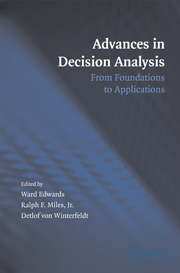Book contents
- Frontmatter
- Contents
- List of Contributors
- Preface
- 1 Introduction
- PART I HISTORY AND FOUNDATIONS OF DECISION ANALYSIS
- PART II STRUCTURING DECISION PROBLEMS
- 6 Defining a Decision Analytic Structure
- 7 Developing Objectives and Attributes
- PART III PROBABILITIES AND BAYES NETS
- PART IV UTILITIES
- PART V RISK ANALYSIS
- PART VI DECISION ANALYSIS IN A BEHAVIORAL AND ORGANIZATIONAL CONTEXT
- PART VII APPLICATIONS OF DECISION ANALYSIS
- Index
- References
7 - Developing Objectives and Attributes
Published online by Cambridge University Press: 05 June 2012
- Frontmatter
- Contents
- List of Contributors
- Preface
- 1 Introduction
- PART I HISTORY AND FOUNDATIONS OF DECISION ANALYSIS
- PART II STRUCTURING DECISION PROBLEMS
- 6 Defining a Decision Analytic Structure
- 7 Developing Objectives and Attributes
- PART III PROBABILITIES AND BAYES NETS
- PART IV UTILITIES
- PART V RISK ANALYSIS
- PART VI DECISION ANALYSIS IN A BEHAVIORAL AND ORGANIZATIONAL CONTEXT
- PART VII APPLICATIONS OF DECISION ANALYSIS
- Index
- References
Summary
ABSTRACT. The fundamental objectives of any decision problem should define why the decision maker is interested in that decision. However, listing a complete set of the fundamental objectives for a decision is not a simple task. It requires creativity, time, some hard thinking, and the recognition that it is important. This chapter offers many suggestions to help do the task well and provides criteria to appraise the quality of the resulting set of fundamental objectives. For an analysis of the alternatives in terms of these objectives, an attribute to measure the achievement of each objective is required. Good attributes are essential for an insightful analysis. This chapter also includes many suggestions to help identify or construct useful attributes as well as criteria to appraise the quality of the resulting attributes. Collectively, the fundamental objectives and corresponding attributes provide the basis for any objective function and for any discussion of the pros and cons of the alternatives.
Introduction
For any decision situation, there is a specific time when it is first recognized. Before that time, there is no conscious awareness of the decision. These decision situations can be categorized depending on how they were elevated to consciousness. Some were caused by an external event, referred to as a trigger that makes it clear that a decision will have to be made. Triggers are caused by circumstances or by people other than the decision maker, the person who needs to make a choice sometime in the future.
Information
- Type
- Chapter
- Information
- Advances in Decision AnalysisFrom Foundations to Applications, pp. 104 - 128Publisher: Cambridge University PressPrint publication year: 2007
References
Accessibility standard: Unknown
Why this information is here
This section outlines the accessibility features of this content - including support for screen readers, full keyboard navigation and high-contrast display options. This may not be relevant for you.Accessibility Information
- 51
- Cited by
